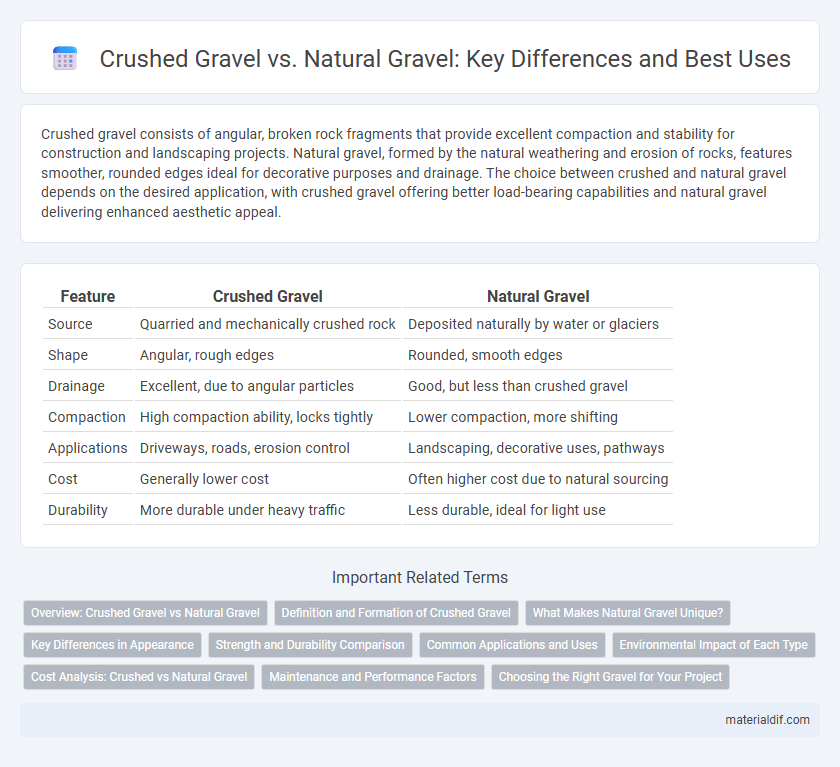Crushed gravel consists of angular, broken rock fragments that provide excellent compaction and stability for construction and landscaping projects. Natural gravel, formed by the natural weathering and erosion of rocks, features smoother, rounded edges ideal for decorative purposes and drainage. The choice between crushed and natural gravel depends on the desired application, with crushed gravel offering better load-bearing capabilities and natural gravel delivering enhanced aesthetic appeal.
Table of Comparison
| Feature | Crushed Gravel | Natural Gravel |
|---|---|---|
| Source | Quarried and mechanically crushed rock | Deposited naturally by water or glaciers |
| Shape | Angular, rough edges | Rounded, smooth edges |
| Drainage | Excellent, due to angular particles | Good, but less than crushed gravel |
| Compaction | High compaction ability, locks tightly | Lower compaction, more shifting |
| Applications | Driveways, roads, erosion control | Landscaping, decorative uses, pathways |
| Cost | Generally lower cost | Often higher cost due to natural sourcing |
| Durability | More durable under heavy traffic | Less durable, ideal for light use |
Overview: Crushed Gravel vs Natural Gravel
Crushed gravel consists of mechanically broken stones with sharp edges, offering superior interlocking and stability for construction projects, while natural gravel is naturally weathered, rounded stones typically found in riverbeds and beaches, providing a smoother texture ideal for decorative purposes. The angular shape of crushed gravel enhances compaction and drainage, making it suitable for heavy-duty applications like driveways and road bases. Natural gravel's rounded particles reduce friction, often used in landscaping and pathways where aesthetic appeal and gentle surface are prioritized.
Definition and Formation of Crushed Gravel
Crushed gravel is produced by mechanically breaking down larger rocks into smaller, angular pieces, resulting in sharp edges and uniform sizes, often derived from limestone, granite, or trap rock. Unlike natural gravel, which is formed by the natural weathering and erosion of rocks over time, resulting in smooth and rounded particles, crushed gravel's angularity provides better compaction and stability for construction projects. The mechanical crushing process enhances its suitability for use in concrete, road bases, and drainage systems due to improved interlocking properties.
What Makes Natural Gravel Unique?
Natural gravel is unique due to its smooth, rounded texture formed through natural weathering and water erosion over time, providing superior drainage and aesthetic appeal compared to crushed gravel. Its varied sizes and organic shapes make it ideal for landscaping projects where a more natural appearance is desired. Unlike crushed gravel, natural gravel's irregular mineral composition also contributes to enhanced soil stability and environmental compatibility.
Key Differences in Appearance
Crushed gravel features sharp, angular edges and a more uniform size, creating a textured and rugged appearance ideal for construction and landscaping projects requiring stability. Natural gravel, shaped by water erosion, has smooth, rounded stones with varied sizes and colors, providing a softer, more organic look suited for decorative uses. The distinct visual contrast between crushed and natural gravel impacts their application based on aesthetic preference and functional requirements.
Strength and Durability Comparison
Crushed gravel offers superior strength and durability compared to natural gravel due to its angular, fractured surfaces that interlock tightly, providing better compaction and load-bearing capacity. Natural gravel, with its smoother, rounded particles, tends to shift and compact less effectively under pressure, leading to reduced stability over time. This makes crushed gravel the preferred choice for high-traffic areas and structural applications where long-lasting performance is critical.
Common Applications and Uses
Crushed gravel is widely used in construction projects such as road base, driveways, and concrete aggregate due to its angular shape, which provides excellent compaction and stability. Natural gravel, often rounded and smoother, is commonly utilized in landscaping, drainage systems, and decorative features where aesthetics and water permeability are important. Both types serve vital roles but are chosen based on specific functional requirements like load-bearing capacity and surface texture.
Environmental Impact of Each Type
Crushed gravel requires extensive quarrying and mechanical processing, resulting in higher energy consumption and increased carbon emissions compared to natural gravel, which is typically sourced directly from riverbeds or glacial deposits with minimal alteration. Natural gravel extraction can disrupt aquatic ecosystems and riverbeds, leading to habitat loss and increased sedimentation, negatively affecting water quality and biodiversity. Choosing between crushed and natural gravel involves balancing the environmental costs of energy-intensive processing against the ecological impact of mining natural deposits.
Cost Analysis: Crushed vs Natural Gravel
Crushed gravel typically costs more than natural gravel due to the intensive processing required to break down rocks into uniform pieces, often ranging from $30 to $50 per ton compared to $20 to $40 per ton for natural gravel. Natural gravel, sourced directly from riverbeds or glacial deposits, generally has lower extraction and processing expenses, making it a more budget-friendly option for landscaping or road base projects. Cost differences can be influenced by local availability, transportation fees, and required specifications, impacting the overall project budget significantly.
Maintenance and Performance Factors
Crushed gravel offers superior compaction and drainage, reducing maintenance needs such as regrading and weed control compared to natural gravel. Its angular edges lock together, enhancing stability and performance under heavy traffic or erosion-prone areas. Natural gravel's smoother, rounded particles may shift more easily, requiring more frequent upkeep to maintain surface integrity.
Choosing the Right Gravel for Your Project
Crushed gravel offers angular edges and better compaction, making it ideal for driveways and construction projects requiring strong base layers. Natural gravel, with its rounded stones, provides better drainage and aesthetic appeal, perfect for landscaping and garden pathways. Selecting the right gravel depends on the project's structural needs and desired visual effect.
Crushed Gravel vs Natural Gravel Infographic

 materialdif.com
materialdif.com